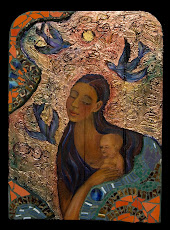

How much of an image does an artist have to change so that they are not infringing on another artist's copyrights? Can you take an image off the internet, change a few things then call the image yours?
Usually, egregious copyright problems involve businesses deciding to "save money" by stealing an image without payment to the creator of that image, then using that image in their marketing, manufacturing or sales process. I wrote an entry about Orphan Works legislation and copyright regarding an incident where the multinational corporation Virgin used a family photograph in an international ad campaign.
Now, two artists are in a legal tussle over just such an issue, and it's about an image you may easily recognize: An Obama poster titled HOPE. The graphic poster was created by Shepard Fairey from the work of freelance photographer Mannie Garcia, who took the photograph the poster mimicked. L. Gordon Crovitz wrote a piece in the Wall Street Journal, The Fine Art of Copyright that details the incident. The New York Times also weighed in with the article by Noam Cohen, Viewing Journalism as a Work of Art.
Terry Gross, host of the NPR's, Fresh Air interviewed Fairey for the show, Shepard Fairey: Inspiration or Infringement? She aired the followup show, Mannie Garcia: The Photo that Sparked "Hope", giving the photographer an opportunity to discuss the situation.
These professional journalists have done a wonderful job covering the issue. The only thing I can add is my opinion, one I've developed through personal experience. After publication of my book, Paint Happy, I had my images stolen and had to spend a lot of money defending my copyrights.
I was curious to see the two images of the photo and poster because, words aside, the visuals speak for themselves. What struck me immediately was the sameness. Fairey's image was what I would term a stylized copy of the original Mannie Garcia photograph. Fairey cropped Garcia's image, and changed the background elements by simplifying the background to a flat color. He tilted the head so slightly that I wouldn't have noticed it as an alteration of the photograph until I listened to Fairey confidently list the tilt as one of his original contributions to the final image. I presume Fairey used a software program like Adobe Illustrator to stylize the natural colors and value transitions of the photograph into flat shapes of color.
Fairey fudged. As a professional graphic artist, Fairey knows about copyright laws. (He is quick to reveal that knowledge when Terry Gross asked about potential parodies of the HOPE poster.)
Here's what happened. He searched for images on the internet until he found an AP image he liked. He didn't bother to research anything about the creator of that image. He took the image for his own purposes without any credit or compensation to the original artist.
Fairey did not show any respect for the work of a peer. He acted like a pirate then calmly explained his actions to Terry Gross as being innocent of anything more than accidental oversight. Only Fairey knows if he would have ever told the truth if this hadn't come to light.
The latest news is that Mannie Garcia is now selling signed prints of the photograph. Many artists work diligently aiming for a break that launches their career to a higher level of visibility and sales. Maybe the light of truth cast on Fairey's actions will lead to increased fairness towards creators of all types. We can hope.
(Thanks Mannie for permission to use these 2 images for this blog entry.)
www.CristinaAcosta.com

















No comments:
Post a Comment